Report: Inter-professional Working in Diagnostic Radiography Analysis
VerifiedAdded on 2020/06/05
|9
|2748
|244
Report
AI Summary
This report offers a critical analysis of inter-professional working within the field of diagnostic radiography, focusing on an article examining the dynamics of teamwork, communication, and workplace culture within healthcare settings. The report delves into the article's methodology, which employs qualitative research methods to explore the impact of factors such as tribalism and communication breakdowns on inter-professional collaboration. Key findings highlight the significance of regular meetings, training, and open discussions to overcome workplace barriers and improve patient care. Furthermore, the report includes a personal reflection, identifying key learning points such as the importance of effective communication and the use of new technologies, transferable skills gained, and areas for future learning, providing a comprehensive overview of the challenges and opportunities associated with fostering a collaborative environment in diagnostic radiography. The report concludes by emphasizing the importance of effective inter-professional working in providing quality healthcare services and the value of qualitative research in understanding employee behavior.
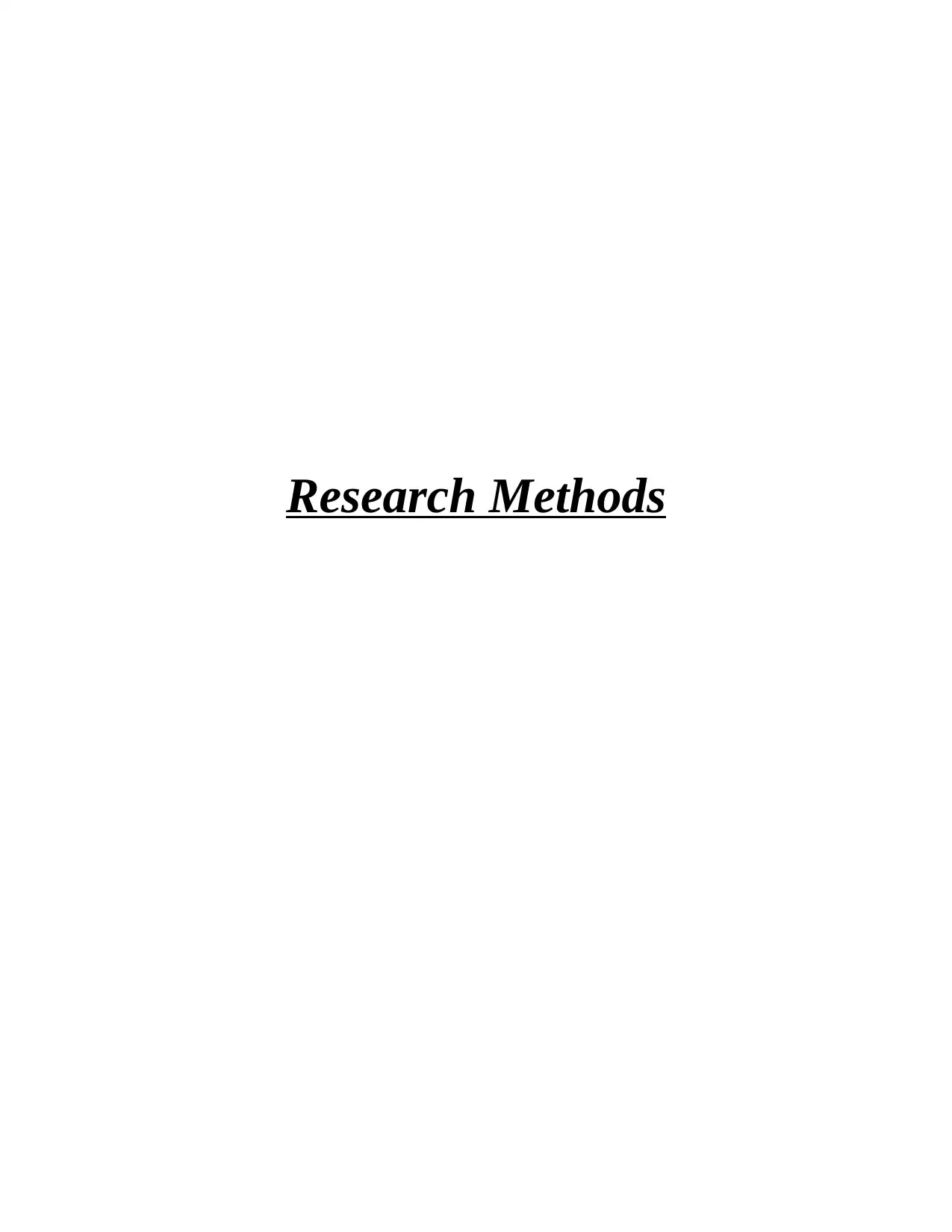
Research Methods
Paraphrase This Document
Need a fresh take? Get an instant paraphrase of this document with our AI Paraphraser
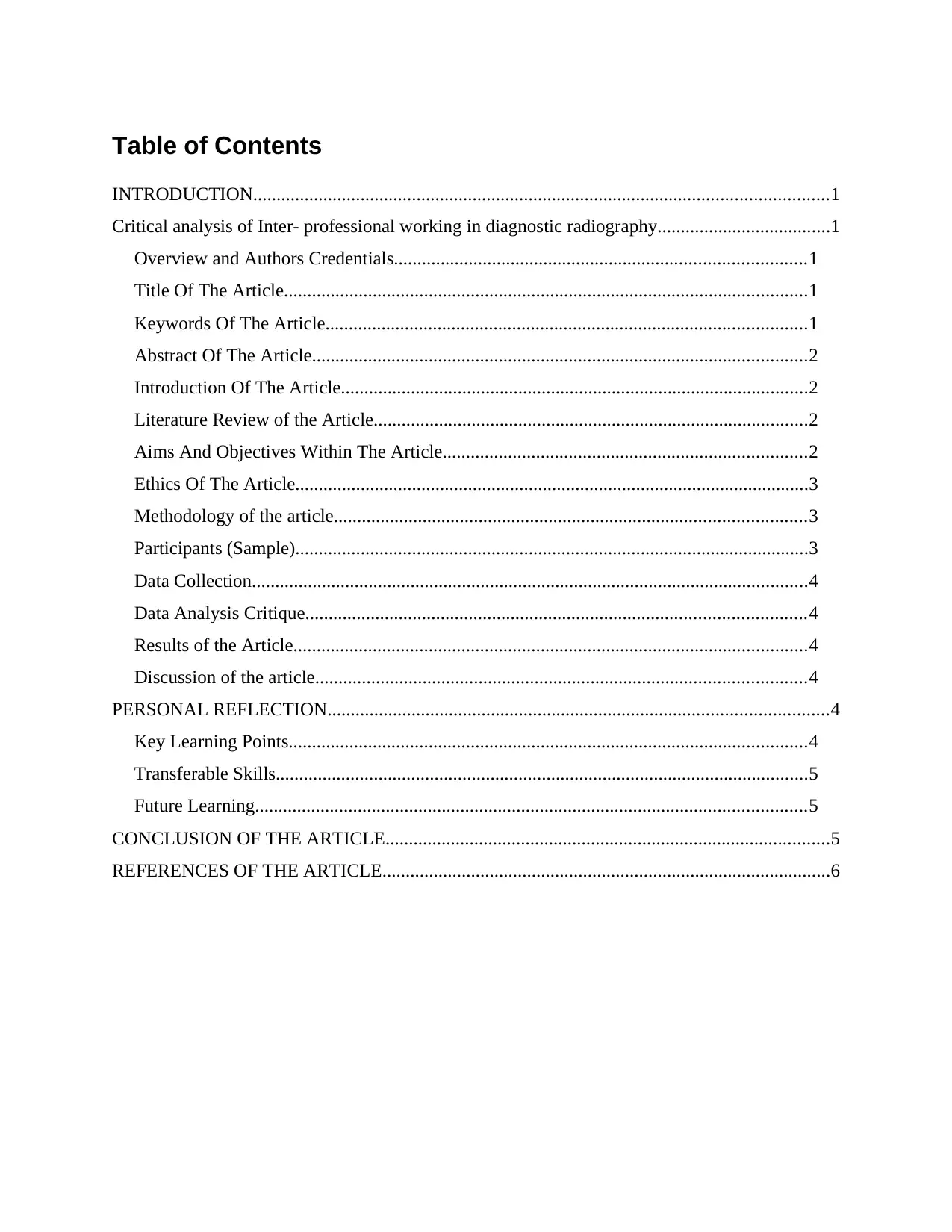
Table of Contents
INTRODUCTION...........................................................................................................................1
Critical analysis of Inter- professional working in diagnostic radiography.....................................1
Overview and Authors Credentials........................................................................................1
Title Of The Article................................................................................................................1
Keywords Of The Article.......................................................................................................1
Abstract Of The Article..........................................................................................................2
Introduction Of The Article....................................................................................................2
Literature Review of the Article.............................................................................................2
Aims And Objectives Within The Article..............................................................................2
Ethics Of The Article..............................................................................................................3
Methodology of the article.....................................................................................................3
Participants (Sample)..............................................................................................................3
Data Collection.......................................................................................................................4
Data Analysis Critique...........................................................................................................4
Results of the Article..............................................................................................................4
Discussion of the article.........................................................................................................4
PERSONAL REFLECTION...........................................................................................................4
Key Learning Points...............................................................................................................4
Transferable Skills..................................................................................................................5
Future Learning......................................................................................................................5
CONCLUSION OF THE ARTICLE...............................................................................................5
REFERENCES OF THE ARTICLE................................................................................................6
INTRODUCTION...........................................................................................................................1
Critical analysis of Inter- professional working in diagnostic radiography.....................................1
Overview and Authors Credentials........................................................................................1
Title Of The Article................................................................................................................1
Keywords Of The Article.......................................................................................................1
Abstract Of The Article..........................................................................................................2
Introduction Of The Article....................................................................................................2
Literature Review of the Article.............................................................................................2
Aims And Objectives Within The Article..............................................................................2
Ethics Of The Article..............................................................................................................3
Methodology of the article.....................................................................................................3
Participants (Sample)..............................................................................................................3
Data Collection.......................................................................................................................4
Data Analysis Critique...........................................................................................................4
Results of the Article..............................................................................................................4
Discussion of the article.........................................................................................................4
PERSONAL REFLECTION...........................................................................................................4
Key Learning Points...............................................................................................................4
Transferable Skills..................................................................................................................5
Future Learning......................................................................................................................5
CONCLUSION OF THE ARTICLE...............................................................................................5
REFERENCES OF THE ARTICLE................................................................................................6
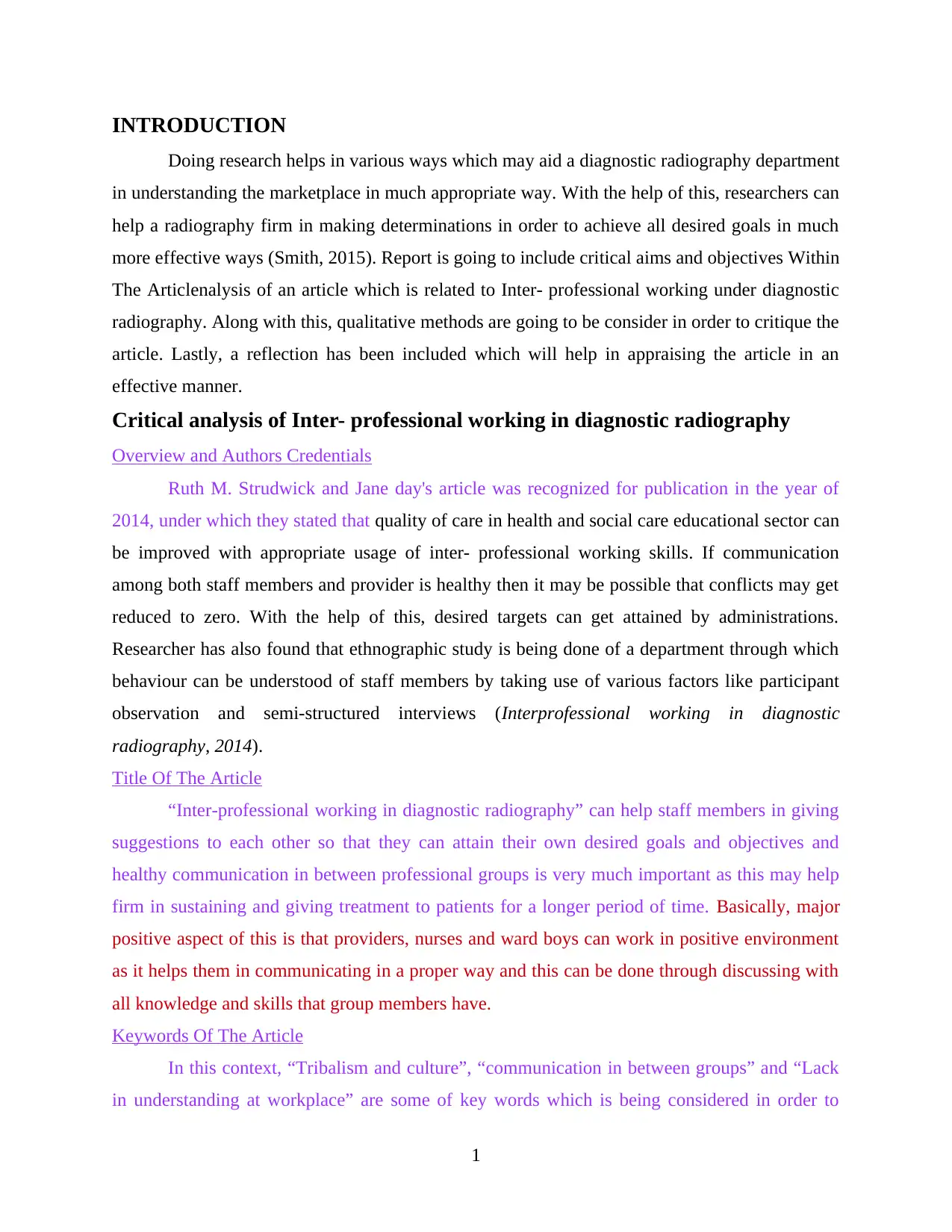
INTRODUCTION
Doing research helps in various ways which may aid a diagnostic radiography department
in understanding the marketplace in much appropriate way. With the help of this, researchers can
help a radiography firm in making determinations in order to achieve all desired goals in much
more effective ways (Smith, 2015). Report is going to include critical aims and objectives Within
The Articlenalysis of an article which is related to Inter- professional working under diagnostic
radiography. Along with this, qualitative methods are going to be consider in order to critique the
article. Lastly, a reflection has been included which will help in appraising the article in an
effective manner.
Critical analysis of Inter- professional working in diagnostic radiography
Overview and Authors Credentials
Ruth M. Strudwick and Jane day's article was recognized for publication in the year of
2014, under which they stated that quality of care in health and social care educational sector can
be improved with appropriate usage of inter- professional working skills. If communication
among both staff members and provider is healthy then it may be possible that conflicts may get
reduced to zero. With the help of this, desired targets can get attained by administrations.
Researcher has also found that ethnographic study is being done of a department through which
behaviour can be understood of staff members by taking use of various factors like participant
observation and semi-structured interviews (Interprofessional working in diagnostic
radiography, 2014).
Title Of The Article
“Inter-professional working in diagnostic radiography” can help staff members in giving
suggestions to each other so that they can attain their own desired goals and objectives and
healthy communication in between professional groups is very much important as this may help
firm in sustaining and giving treatment to patients for a longer period of time. Basically, major
positive aspect of this is that providers, nurses and ward boys can work in positive environment
as it helps them in communicating in a proper way and this can be done through discussing with
all knowledge and skills that group members have.
Keywords Of The Article
In this context, “Tribalism and culture”, “communication in between groups” and “Lack
in understanding at workplace” are some of key words which is being considered in order to
1
Doing research helps in various ways which may aid a diagnostic radiography department
in understanding the marketplace in much appropriate way. With the help of this, researchers can
help a radiography firm in making determinations in order to achieve all desired goals in much
more effective ways (Smith, 2015). Report is going to include critical aims and objectives Within
The Articlenalysis of an article which is related to Inter- professional working under diagnostic
radiography. Along with this, qualitative methods are going to be consider in order to critique the
article. Lastly, a reflection has been included which will help in appraising the article in an
effective manner.
Critical analysis of Inter- professional working in diagnostic radiography
Overview and Authors Credentials
Ruth M. Strudwick and Jane day's article was recognized for publication in the year of
2014, under which they stated that quality of care in health and social care educational sector can
be improved with appropriate usage of inter- professional working skills. If communication
among both staff members and provider is healthy then it may be possible that conflicts may get
reduced to zero. With the help of this, desired targets can get attained by administrations.
Researcher has also found that ethnographic study is being done of a department through which
behaviour can be understood of staff members by taking use of various factors like participant
observation and semi-structured interviews (Interprofessional working in diagnostic
radiography, 2014).
Title Of The Article
“Inter-professional working in diagnostic radiography” can help staff members in giving
suggestions to each other so that they can attain their own desired goals and objectives and
healthy communication in between professional groups is very much important as this may help
firm in sustaining and giving treatment to patients for a longer period of time. Basically, major
positive aspect of this is that providers, nurses and ward boys can work in positive environment
as it helps them in communicating in a proper way and this can be done through discussing with
all knowledge and skills that group members have.
Keywords Of The Article
In this context, “Tribalism and culture”, “communication in between groups” and “Lack
in understanding at workplace” are some of key words which is being considered in order to
1
⊘ This is a preview!⊘
Do you want full access?
Subscribe today to unlock all pages.

Trusted by 1+ million students worldwide
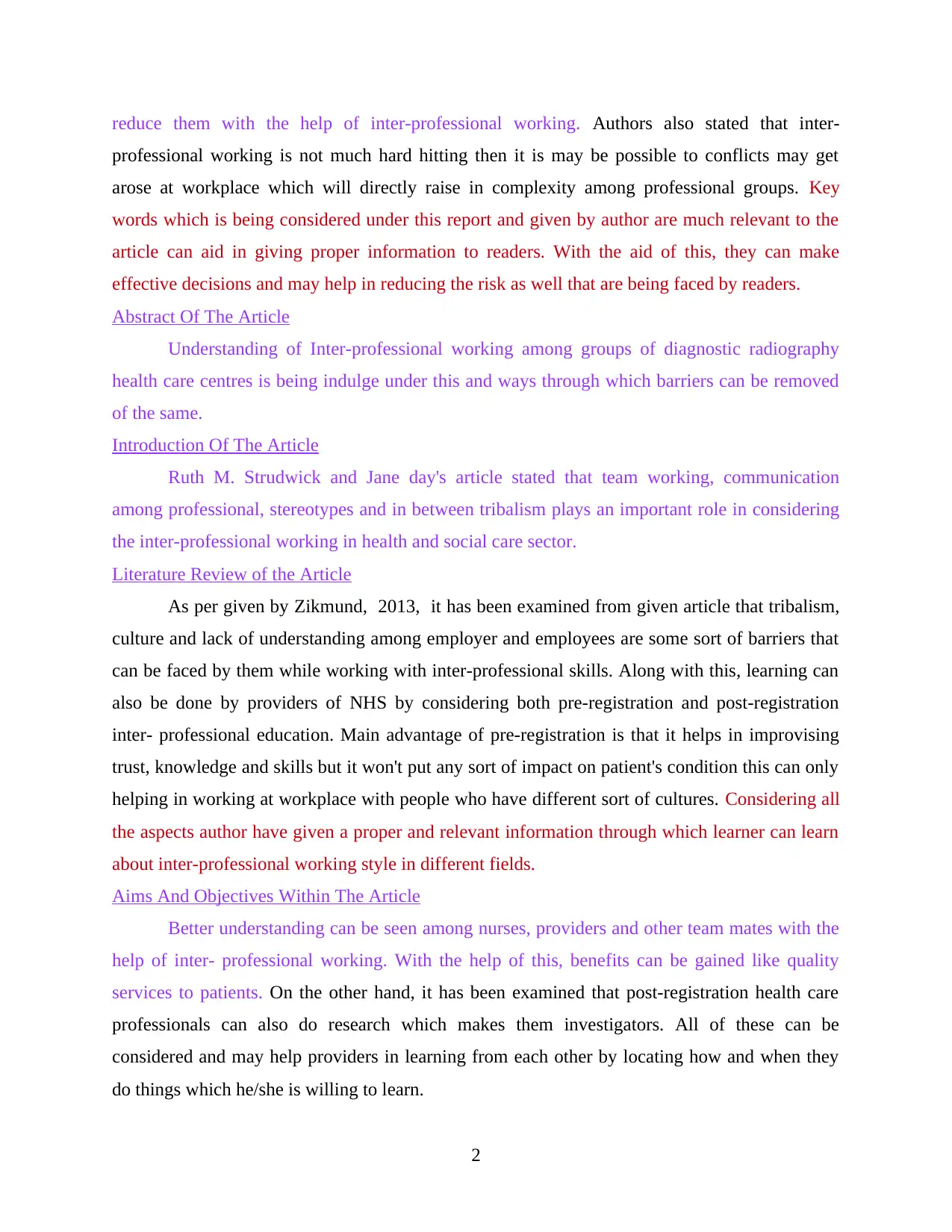
reduce them with the help of inter-professional working. Authors also stated that inter-
professional working is not much hard hitting then it is may be possible to conflicts may get
arose at workplace which will directly raise in complexity among professional groups. Key
words which is being considered under this report and given by author are much relevant to the
article can aid in giving proper information to readers. With the aid of this, they can make
effective decisions and may help in reducing the risk as well that are being faced by readers.
Abstract Of The Article
Understanding of Inter-professional working among groups of diagnostic radiography
health care centres is being indulge under this and ways through which barriers can be removed
of the same.
Introduction Of The Article
Ruth M. Strudwick and Jane day's article stated that team working, communication
among professional, stereotypes and in between tribalism plays an important role in considering
the inter-professional working in health and social care sector.
Literature Review of the Article
As per given by Zikmund, 2013, it has been examined from given article that tribalism,
culture and lack of understanding among employer and employees are some sort of barriers that
can be faced by them while working with inter-professional skills. Along with this, learning can
also be done by providers of NHS by considering both pre-registration and post-registration
inter- professional education. Main advantage of pre-registration is that it helps in improvising
trust, knowledge and skills but it won't put any sort of impact on patient's condition this can only
helping in working at workplace with people who have different sort of cultures. Considering all
the aspects author have given a proper and relevant information through which learner can learn
about inter-professional working style in different fields.
Aims And Objectives Within The Article
Better understanding can be seen among nurses, providers and other team mates with the
help of inter- professional working. With the help of this, benefits can be gained like quality
services to patients. On the other hand, it has been examined that post-registration health care
professionals can also do research which makes them investigators. All of these can be
considered and may help providers in learning from each other by locating how and when they
do things which he/she is willing to learn.
2
professional working is not much hard hitting then it is may be possible to conflicts may get
arose at workplace which will directly raise in complexity among professional groups. Key
words which is being considered under this report and given by author are much relevant to the
article can aid in giving proper information to readers. With the aid of this, they can make
effective decisions and may help in reducing the risk as well that are being faced by readers.
Abstract Of The Article
Understanding of Inter-professional working among groups of diagnostic radiography
health care centres is being indulge under this and ways through which barriers can be removed
of the same.
Introduction Of The Article
Ruth M. Strudwick and Jane day's article stated that team working, communication
among professional, stereotypes and in between tribalism plays an important role in considering
the inter-professional working in health and social care sector.
Literature Review of the Article
As per given by Zikmund, 2013, it has been examined from given article that tribalism,
culture and lack of understanding among employer and employees are some sort of barriers that
can be faced by them while working with inter-professional skills. Along with this, learning can
also be done by providers of NHS by considering both pre-registration and post-registration
inter- professional education. Main advantage of pre-registration is that it helps in improvising
trust, knowledge and skills but it won't put any sort of impact on patient's condition this can only
helping in working at workplace with people who have different sort of cultures. Considering all
the aspects author have given a proper and relevant information through which learner can learn
about inter-professional working style in different fields.
Aims And Objectives Within The Article
Better understanding can be seen among nurses, providers and other team mates with the
help of inter- professional working. With the help of this, benefits can be gained like quality
services to patients. On the other hand, it has been examined that post-registration health care
professionals can also do research which makes them investigators. All of these can be
considered and may help providers in learning from each other by locating how and when they
do things which he/she is willing to learn.
2
Paraphrase This Document
Need a fresh take? Get an instant paraphrase of this document with our AI Paraphraser
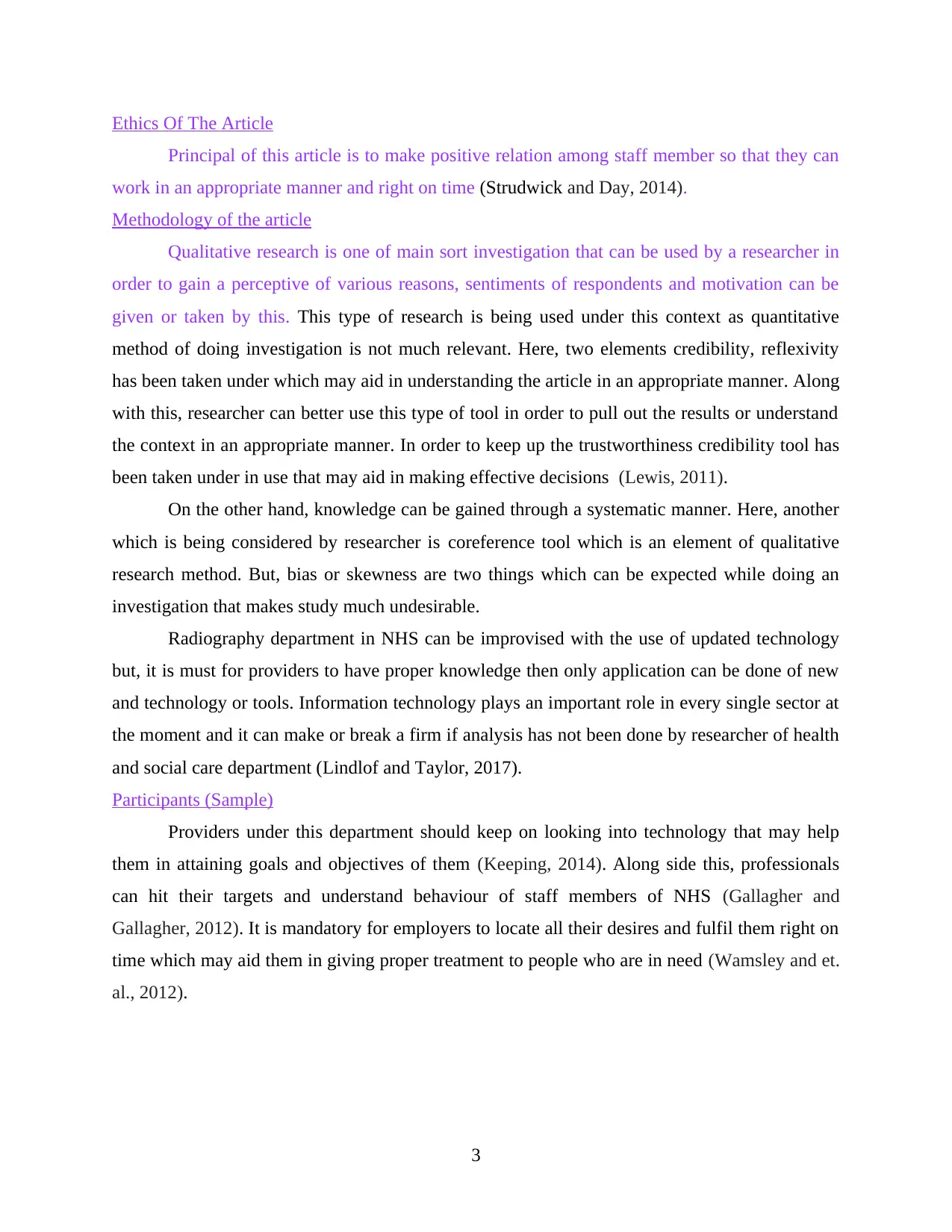
Ethics Of The Article
Principal of this article is to make positive relation among staff member so that they can
work in an appropriate manner and right on time (Strudwick and Day, 2014).
Methodology of the article
Qualitative research is one of main sort investigation that can be used by a researcher in
order to gain a perceptive of various reasons, sentiments of respondents and motivation can be
given or taken by this. This type of research is being used under this context as quantitative
method of doing investigation is not much relevant. Here, two elements credibility, reflexivity
has been taken under which may aid in understanding the article in an appropriate manner. Along
with this, researcher can better use this type of tool in order to pull out the results or understand
the context in an appropriate manner. In order to keep up the trustworthiness credibility tool has
been taken under in use that may aid in making effective decisions (Lewis, 2011).
On the other hand, knowledge can be gained through a systematic manner. Here, another
which is being considered by researcher is coreference tool which is an element of qualitative
research method. But, bias or skewness are two things which can be expected while doing an
investigation that makes study much undesirable.
Radiography department in NHS can be improvised with the use of updated technology
but, it is must for providers to have proper knowledge then only application can be done of new
and technology or tools. Information technology plays an important role in every single sector at
the moment and it can make or break a firm if analysis has not been done by researcher of health
and social care department (Lindlof and Taylor, 2017).
Participants (Sample)
Providers under this department should keep on looking into technology that may help
them in attaining goals and objectives of them (Keeping, 2014). Along side this, professionals
can hit their targets and understand behaviour of staff members of NHS (Gallagher and
Gallagher, 2012). It is mandatory for employers to locate all their desires and fulfil them right on
time which may aid them in giving proper treatment to people who are in need (Wamsley and et.
al., 2012).
3
Principal of this article is to make positive relation among staff member so that they can
work in an appropriate manner and right on time (Strudwick and Day, 2014).
Methodology of the article
Qualitative research is one of main sort investigation that can be used by a researcher in
order to gain a perceptive of various reasons, sentiments of respondents and motivation can be
given or taken by this. This type of research is being used under this context as quantitative
method of doing investigation is not much relevant. Here, two elements credibility, reflexivity
has been taken under which may aid in understanding the article in an appropriate manner. Along
with this, researcher can better use this type of tool in order to pull out the results or understand
the context in an appropriate manner. In order to keep up the trustworthiness credibility tool has
been taken under in use that may aid in making effective decisions (Lewis, 2011).
On the other hand, knowledge can be gained through a systematic manner. Here, another
which is being considered by researcher is coreference tool which is an element of qualitative
research method. But, bias or skewness are two things which can be expected while doing an
investigation that makes study much undesirable.
Radiography department in NHS can be improvised with the use of updated technology
but, it is must for providers to have proper knowledge then only application can be done of new
and technology or tools. Information technology plays an important role in every single sector at
the moment and it can make or break a firm if analysis has not been done by researcher of health
and social care department (Lindlof and Taylor, 2017).
Participants (Sample)
Providers under this department should keep on looking into technology that may help
them in attaining goals and objectives of them (Keeping, 2014). Along side this, professionals
can hit their targets and understand behaviour of staff members of NHS (Gallagher and
Gallagher, 2012). It is mandatory for employers to locate all their desires and fulfil them right on
time which may aid them in giving proper treatment to people who are in need (Wamsley and et.
al., 2012).
3
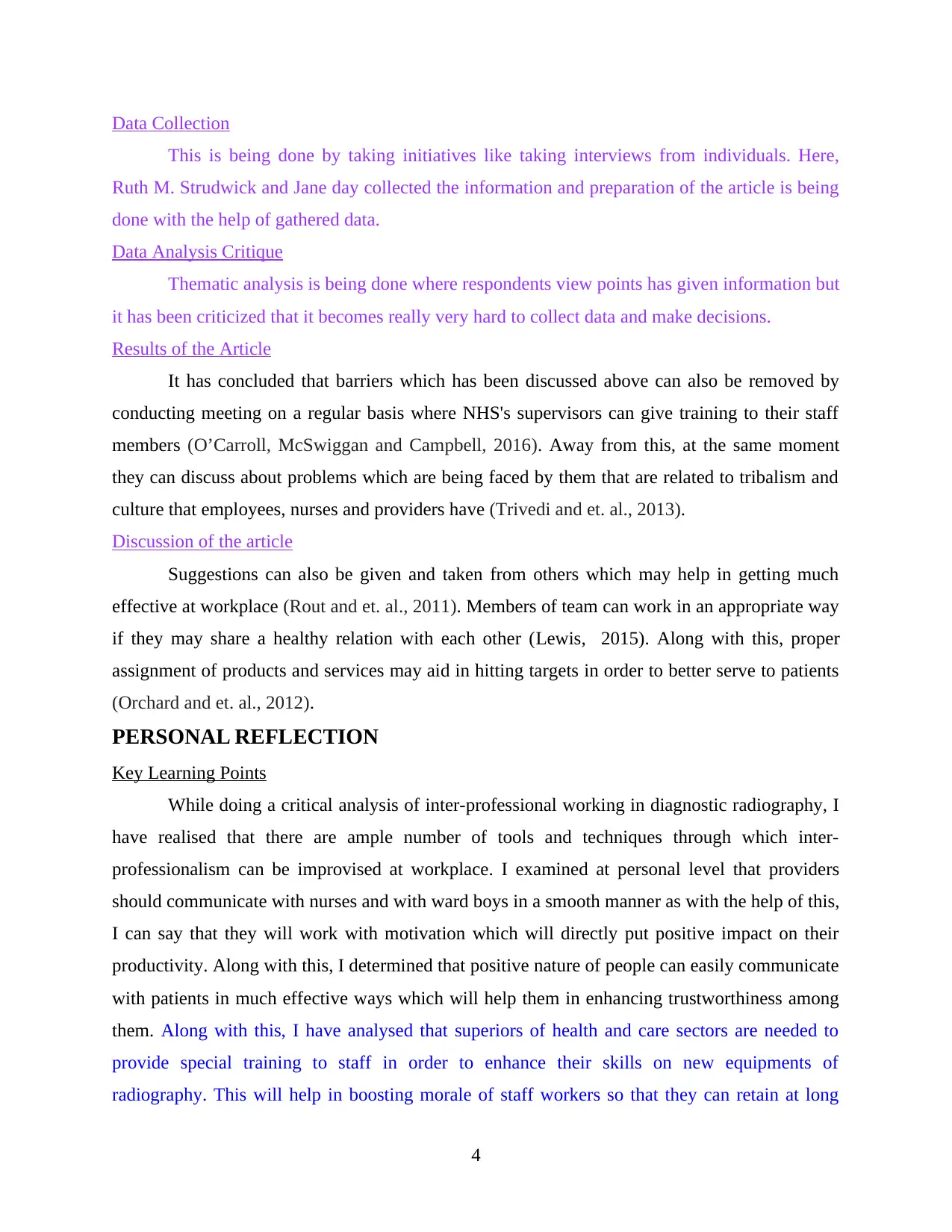
Data Collection
This is being done by taking initiatives like taking interviews from individuals. Here,
Ruth M. Strudwick and Jane day collected the information and preparation of the article is being
done with the help of gathered data.
Data Analysis Critique
Thematic analysis is being done where respondents view points has given information but
it has been criticized that it becomes really very hard to collect data and make decisions.
Results of the Article
It has concluded that barriers which has been discussed above can also be removed by
conducting meeting on a regular basis where NHS's supervisors can give training to their staff
members (O’Carroll, McSwiggan and Campbell, 2016). Away from this, at the same moment
they can discuss about problems which are being faced by them that are related to tribalism and
culture that employees, nurses and providers have (Trivedi and et. al., 2013).
Discussion of the article
Suggestions can also be given and taken from others which may help in getting much
effective at workplace (Rout and et. al., 2011). Members of team can work in an appropriate way
if they may share a healthy relation with each other (Lewis, 2015). Along with this, proper
assignment of products and services may aid in hitting targets in order to better serve to patients
(Orchard and et. al., 2012).
PERSONAL REFLECTION
Key Learning Points
While doing a critical analysis of inter-professional working in diagnostic radiography, I
have realised that there are ample number of tools and techniques through which inter-
professionalism can be improvised at workplace. I examined at personal level that providers
should communicate with nurses and with ward boys in a smooth manner as with the help of this,
I can say that they will work with motivation which will directly put positive impact on their
productivity. Along with this, I determined that positive nature of people can easily communicate
with patients in much effective ways which will help them in enhancing trustworthiness among
them. Along with this, I have analysed that superiors of health and care sectors are needed to
provide special training to staff in order to enhance their skills on new equipments of
radiography. This will help in boosting morale of staff workers so that they can retain at long
4
This is being done by taking initiatives like taking interviews from individuals. Here,
Ruth M. Strudwick and Jane day collected the information and preparation of the article is being
done with the help of gathered data.
Data Analysis Critique
Thematic analysis is being done where respondents view points has given information but
it has been criticized that it becomes really very hard to collect data and make decisions.
Results of the Article
It has concluded that barriers which has been discussed above can also be removed by
conducting meeting on a regular basis where NHS's supervisors can give training to their staff
members (O’Carroll, McSwiggan and Campbell, 2016). Away from this, at the same moment
they can discuss about problems which are being faced by them that are related to tribalism and
culture that employees, nurses and providers have (Trivedi and et. al., 2013).
Discussion of the article
Suggestions can also be given and taken from others which may help in getting much
effective at workplace (Rout and et. al., 2011). Members of team can work in an appropriate way
if they may share a healthy relation with each other (Lewis, 2015). Along with this, proper
assignment of products and services may aid in hitting targets in order to better serve to patients
(Orchard and et. al., 2012).
PERSONAL REFLECTION
Key Learning Points
While doing a critical analysis of inter-professional working in diagnostic radiography, I
have realised that there are ample number of tools and techniques through which inter-
professionalism can be improvised at workplace. I examined at personal level that providers
should communicate with nurses and with ward boys in a smooth manner as with the help of this,
I can say that they will work with motivation which will directly put positive impact on their
productivity. Along with this, I determined that positive nature of people can easily communicate
with patients in much effective ways which will help them in enhancing trustworthiness among
them. Along with this, I have analysed that superiors of health and care sectors are needed to
provide special training to staff in order to enhance their skills on new equipments of
radiography. This will help in boosting morale of staff workers so that they can retain at long
4
⊘ This is a preview!⊘
Do you want full access?
Subscribe today to unlock all pages.

Trusted by 1+ million students worldwide
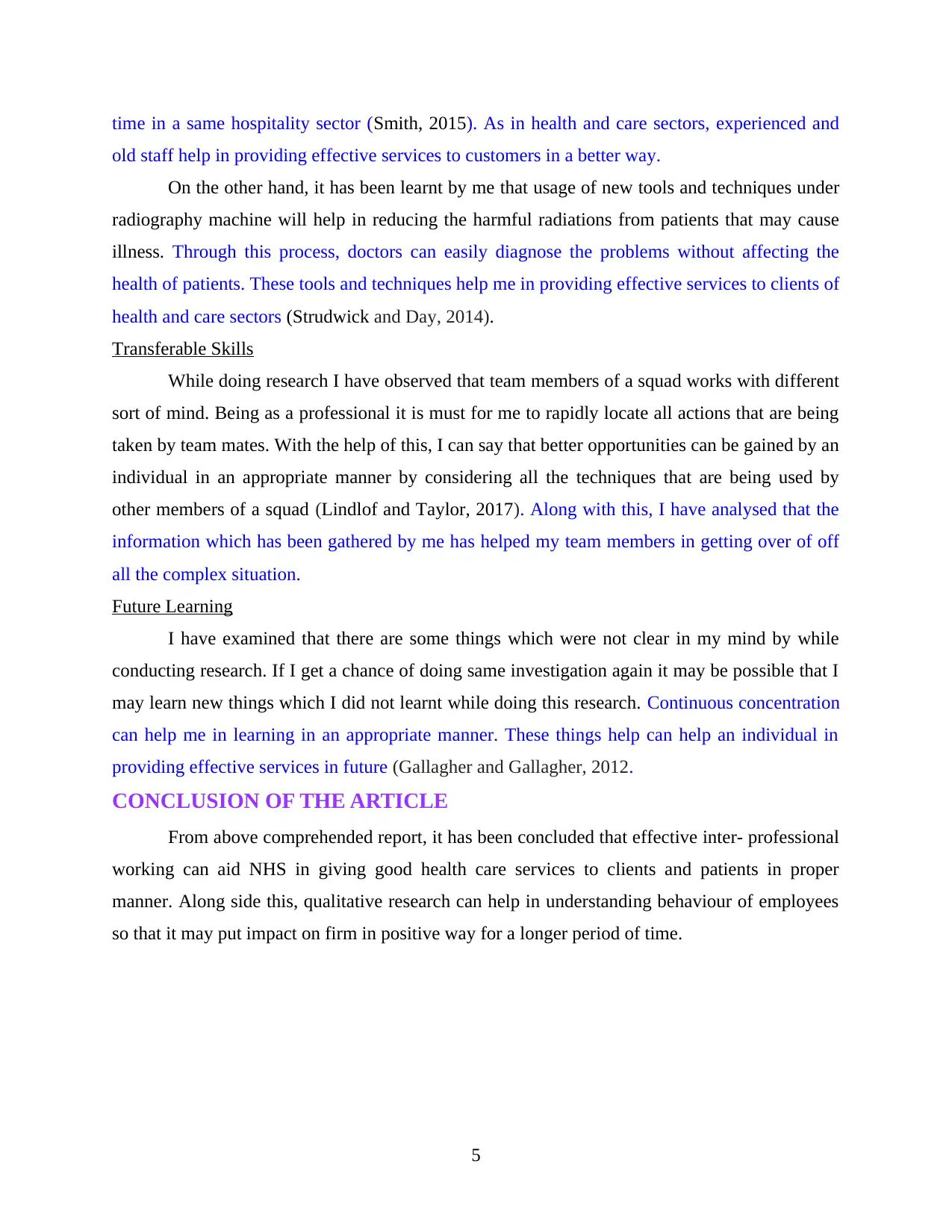
time in a same hospitality sector (Smith, 2015). As in health and care sectors, experienced and
old staff help in providing effective services to customers in a better way.
On the other hand, it has been learnt by me that usage of new tools and techniques under
radiography machine will help in reducing the harmful radiations from patients that may cause
illness. Through this process, doctors can easily diagnose the problems without affecting the
health of patients. These tools and techniques help me in providing effective services to clients of
health and care sectors (Strudwick and Day, 2014).
Transferable Skills
While doing research I have observed that team members of a squad works with different
sort of mind. Being as a professional it is must for me to rapidly locate all actions that are being
taken by team mates. With the help of this, I can say that better opportunities can be gained by an
individual in an appropriate manner by considering all the techniques that are being used by
other members of a squad (Lindlof and Taylor, 2017). Along with this, I have analysed that the
information which has been gathered by me has helped my team members in getting over of off
all the complex situation.
Future Learning
I have examined that there are some things which were not clear in my mind by while
conducting research. If I get a chance of doing same investigation again it may be possible that I
may learn new things which I did not learnt while doing this research. Continuous concentration
can help me in learning in an appropriate manner. These things help can help an individual in
providing effective services in future (Gallagher and Gallagher, 2012.
CONCLUSION OF THE ARTICLE
From above comprehended report, it has been concluded that effective inter- professional
working can aid NHS in giving good health care services to clients and patients in proper
manner. Along side this, qualitative research can help in understanding behaviour of employees
so that it may put impact on firm in positive way for a longer period of time.
5
old staff help in providing effective services to customers in a better way.
On the other hand, it has been learnt by me that usage of new tools and techniques under
radiography machine will help in reducing the harmful radiations from patients that may cause
illness. Through this process, doctors can easily diagnose the problems without affecting the
health of patients. These tools and techniques help me in providing effective services to clients of
health and care sectors (Strudwick and Day, 2014).
Transferable Skills
While doing research I have observed that team members of a squad works with different
sort of mind. Being as a professional it is must for me to rapidly locate all actions that are being
taken by team mates. With the help of this, I can say that better opportunities can be gained by an
individual in an appropriate manner by considering all the techniques that are being used by
other members of a squad (Lindlof and Taylor, 2017). Along with this, I have analysed that the
information which has been gathered by me has helped my team members in getting over of off
all the complex situation.
Future Learning
I have examined that there are some things which were not clear in my mind by while
conducting research. If I get a chance of doing same investigation again it may be possible that I
may learn new things which I did not learnt while doing this research. Continuous concentration
can help me in learning in an appropriate manner. These things help can help an individual in
providing effective services in future (Gallagher and Gallagher, 2012.
CONCLUSION OF THE ARTICLE
From above comprehended report, it has been concluded that effective inter- professional
working can aid NHS in giving good health care services to clients and patients in proper
manner. Along side this, qualitative research can help in understanding behaviour of employees
so that it may put impact on firm in positive way for a longer period of time.
5
Paraphrase This Document
Need a fresh take? Get an instant paraphrase of this document with our AI Paraphraser
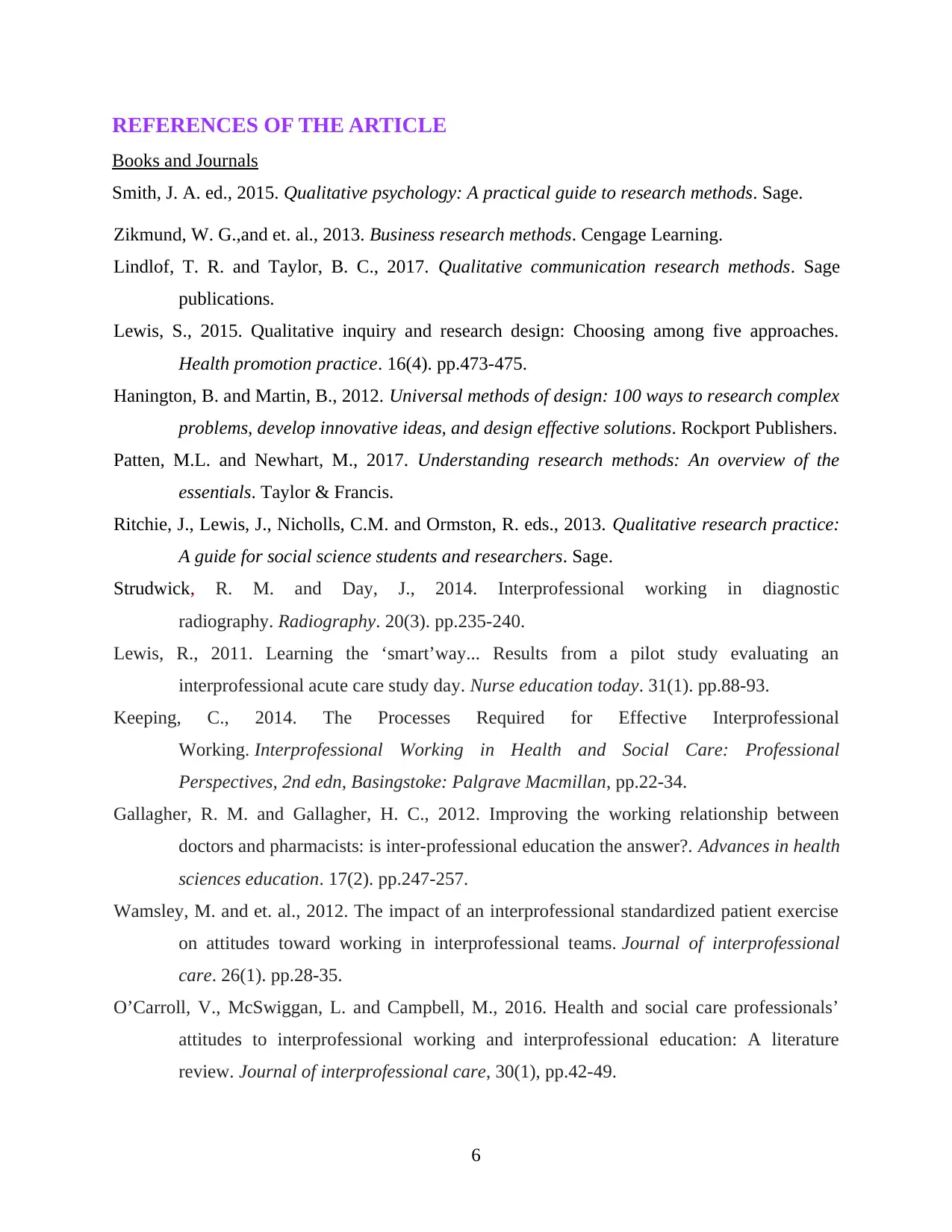
REFERENCES OF THE ARTICLE
Books and Journals
Smith, J. A. ed., 2015. Qualitative psychology: A practical guide to research methods. Sage.
Zikmund, W. G.,and et. al., 2013. Business research methods. Cengage Learning.
Lindlof, T. R. and Taylor, B. C., 2017. Qualitative communication research methods. Sage
publications.
Lewis, S., 2015. Qualitative inquiry and research design: Choosing among five approaches.
Health promotion practice. 16(4). pp.473-475.
Hanington, B. and Martin, B., 2012. Universal methods of design: 100 ways to research complex
problems, develop innovative ideas, and design effective solutions. Rockport Publishers.
Patten, M.L. and Newhart, M., 2017. Understanding research methods: An overview of the
essentials. Taylor & Francis.
Ritchie, J., Lewis, J., Nicholls, C.M. and Ormston, R. eds., 2013. Qualitative research practice:
A guide for social science students and researchers. Sage.
Strudwick, R. M. and Day, J., 2014. Interprofessional working in diagnostic
radiography. Radiography. 20(3). pp.235-240.
Lewis, R., 2011. Learning the ‘smart’way... Results from a pilot study evaluating an
interprofessional acute care study day. Nurse education today. 31(1). pp.88-93.
Keeping, C., 2014. The Processes Required for Effective Interprofessional
Working. Interprofessional Working in Health and Social Care: Professional
Perspectives, 2nd edn, Basingstoke: Palgrave Macmillan, pp.22-34.
Gallagher, R. M. and Gallagher, H. C., 2012. Improving the working relationship between
doctors and pharmacists: is inter-professional education the answer?. Advances in health
sciences education. 17(2). pp.247-257.
Wamsley, M. and et. al., 2012. The impact of an interprofessional standardized patient exercise
on attitudes toward working in interprofessional teams. Journal of interprofessional
care. 26(1). pp.28-35.
O’Carroll, V., McSwiggan, L. and Campbell, M., 2016. Health and social care professionals’
attitudes to interprofessional working and interprofessional education: A literature
review. Journal of interprofessional care, 30(1), pp.42-49.
6
Books and Journals
Smith, J. A. ed., 2015. Qualitative psychology: A practical guide to research methods. Sage.
Zikmund, W. G.,and et. al., 2013. Business research methods. Cengage Learning.
Lindlof, T. R. and Taylor, B. C., 2017. Qualitative communication research methods. Sage
publications.
Lewis, S., 2015. Qualitative inquiry and research design: Choosing among five approaches.
Health promotion practice. 16(4). pp.473-475.
Hanington, B. and Martin, B., 2012. Universal methods of design: 100 ways to research complex
problems, develop innovative ideas, and design effective solutions. Rockport Publishers.
Patten, M.L. and Newhart, M., 2017. Understanding research methods: An overview of the
essentials. Taylor & Francis.
Ritchie, J., Lewis, J., Nicholls, C.M. and Ormston, R. eds., 2013. Qualitative research practice:
A guide for social science students and researchers. Sage.
Strudwick, R. M. and Day, J., 2014. Interprofessional working in diagnostic
radiography. Radiography. 20(3). pp.235-240.
Lewis, R., 2011. Learning the ‘smart’way... Results from a pilot study evaluating an
interprofessional acute care study day. Nurse education today. 31(1). pp.88-93.
Keeping, C., 2014. The Processes Required for Effective Interprofessional
Working. Interprofessional Working in Health and Social Care: Professional
Perspectives, 2nd edn, Basingstoke: Palgrave Macmillan, pp.22-34.
Gallagher, R. M. and Gallagher, H. C., 2012. Improving the working relationship between
doctors and pharmacists: is inter-professional education the answer?. Advances in health
sciences education. 17(2). pp.247-257.
Wamsley, M. and et. al., 2012. The impact of an interprofessional standardized patient exercise
on attitudes toward working in interprofessional teams. Journal of interprofessional
care. 26(1). pp.28-35.
O’Carroll, V., McSwiggan, L. and Campbell, M., 2016. Health and social care professionals’
attitudes to interprofessional working and interprofessional education: A literature
review. Journal of interprofessional care, 30(1), pp.42-49.
6
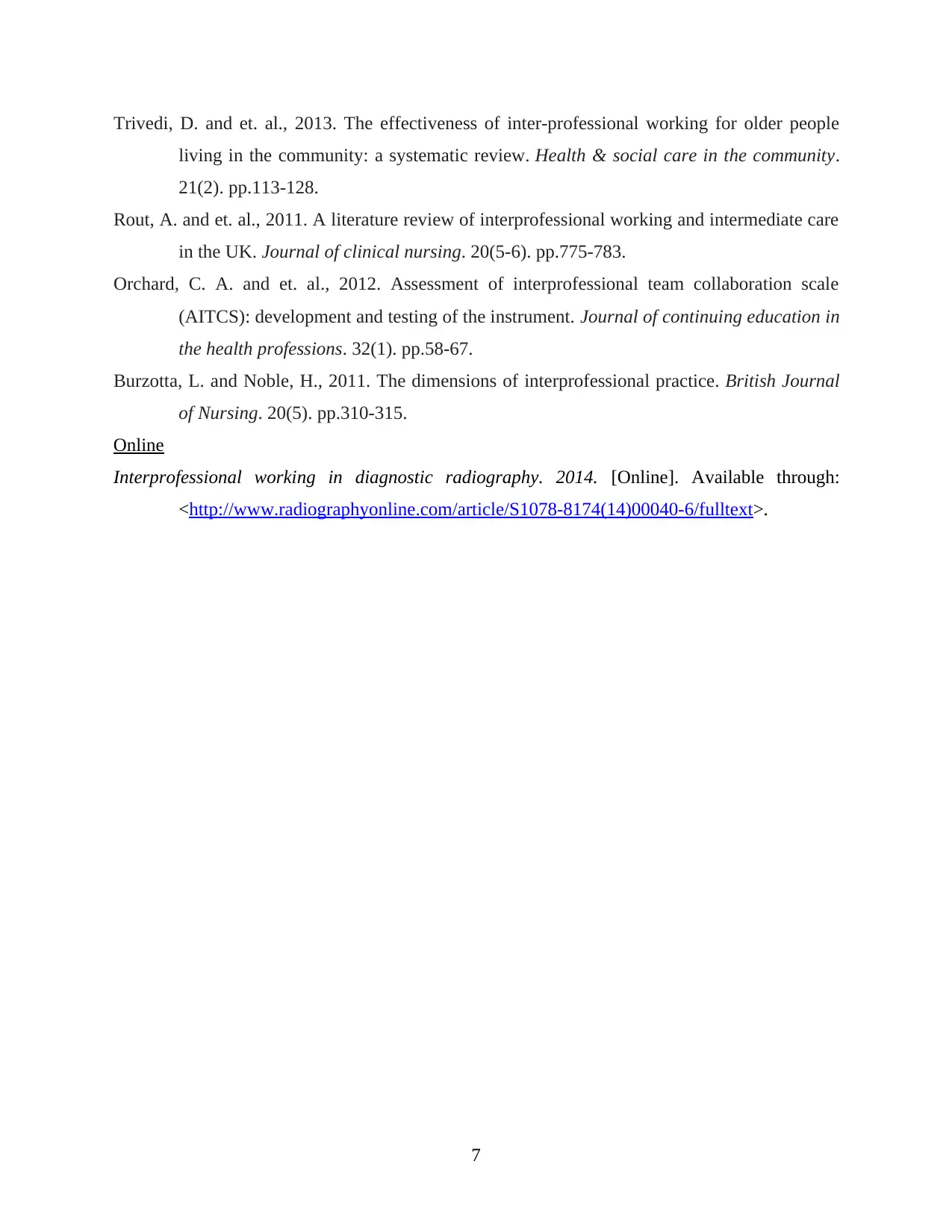
Trivedi, D. and et. al., 2013. The effectiveness of inter‐professional working for older people
living in the community: a systematic review. Health & social care in the community.
21(2). pp.113-128.
Rout, A. and et. al., 2011. A literature review of interprofessional working and intermediate care
in the UK. Journal of clinical nursing. 20(5‐6). pp.775-783.
Orchard, C. A. and et. al., 2012. Assessment of interprofessional team collaboration scale
(AITCS): development and testing of the instrument. Journal of continuing education in
the health professions. 32(1). pp.58-67.
Burzotta, L. and Noble, H., 2011. The dimensions of interprofessional practice. British Journal
of Nursing. 20(5). pp.310-315.
Online
Interprofessional working in diagnostic radiography. 2014. [Online]. Available through:
<http://www.radiographyonline.com/article/S1078-8174(14)00040-6/fulltext>.
7
living in the community: a systematic review. Health & social care in the community.
21(2). pp.113-128.
Rout, A. and et. al., 2011. A literature review of interprofessional working and intermediate care
in the UK. Journal of clinical nursing. 20(5‐6). pp.775-783.
Orchard, C. A. and et. al., 2012. Assessment of interprofessional team collaboration scale
(AITCS): development and testing of the instrument. Journal of continuing education in
the health professions. 32(1). pp.58-67.
Burzotta, L. and Noble, H., 2011. The dimensions of interprofessional practice. British Journal
of Nursing. 20(5). pp.310-315.
Online
Interprofessional working in diagnostic radiography. 2014. [Online]. Available through:
<http://www.radiographyonline.com/article/S1078-8174(14)00040-6/fulltext>.
7
⊘ This is a preview!⊘
Do you want full access?
Subscribe today to unlock all pages.

Trusted by 1+ million students worldwide
1 out of 9
Related Documents
Your All-in-One AI-Powered Toolkit for Academic Success.
+13062052269
info@desklib.com
Available 24*7 on WhatsApp / Email
![[object Object]](/_next/static/media/star-bottom.7253800d.svg)
Unlock your academic potential
Copyright © 2020–2025 A2Z Services. All Rights Reserved. Developed and managed by ZUCOL.





